CMI 311 Assessment Booklet: Contributing to Project Delivery at PTS
VerifiedAdded on 2020/10/23
|24
|7004
|321
Homework Assignment
AI Summary
This document presents a completed CMI 311 assessment booklet focused on contributing to the delivery of a project. The assignment covers key concepts such as the differences between projects and everyday activities, reasons organizations use projects, and various project types (simple, complex, short-term, and long-term) with examples. It also delves into the project lifecycle stages (initiation, planning, implementation, and closure), stakeholder engagement, and project plan components. The assessment emphasizes practical application and provides examples of how these concepts are applied within an organization, specifically referencing a casino environment. The assignment is designed to demonstrate an understanding of how to support individuals to perform well and exceed expectations in project settings, aligning with CMI Level 3 in Principles in Management and Leadership.
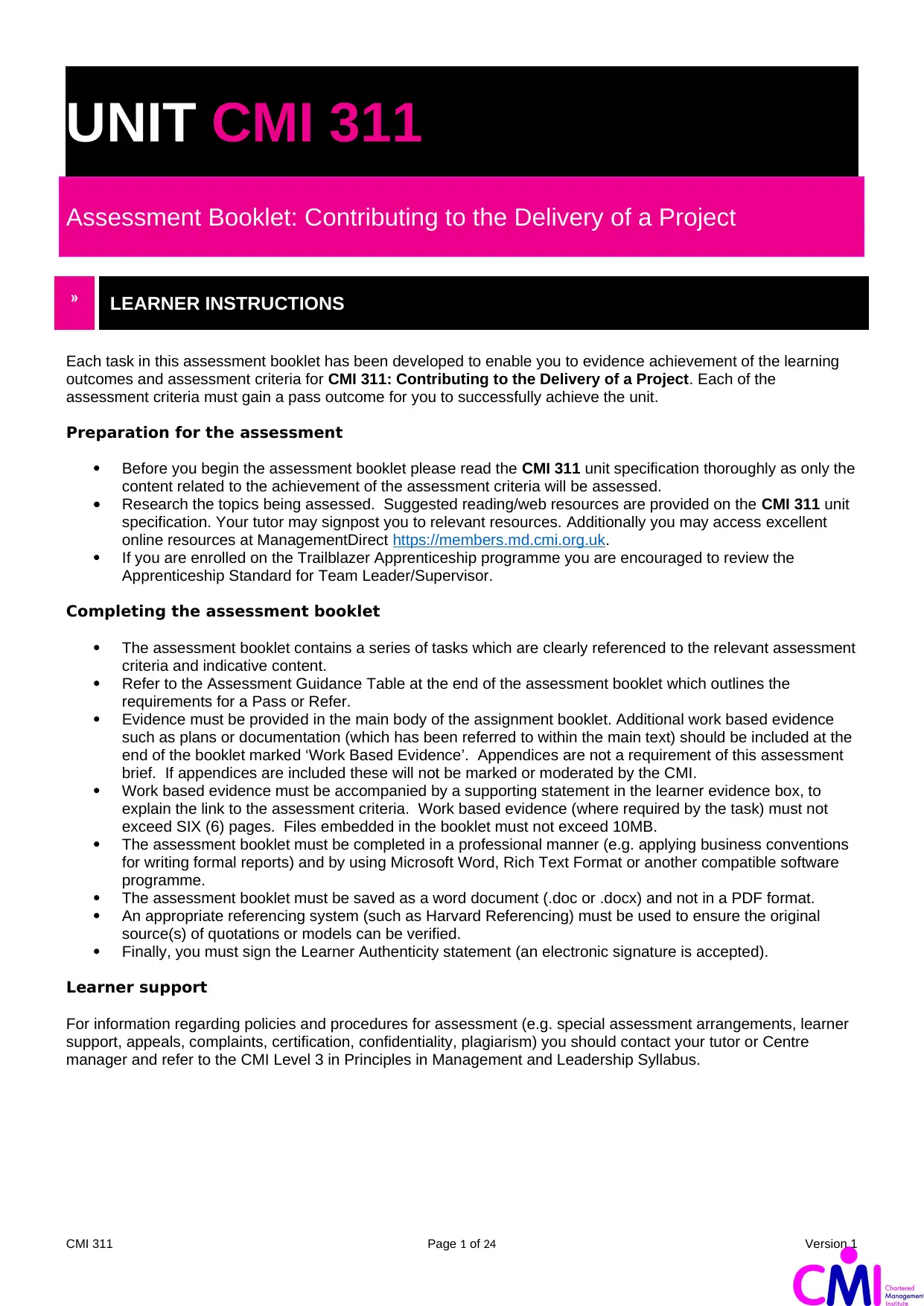
UNIT CMI 311
Assessment Booklet: Contributing to the Delivery of a Project
» LEARNER INSTRUCTIONS
Each task in this assessment booklet has been developed to enable you to evidence achievement of the learning
outcomes and assessment criteria for CMI 311: Contributing to the Delivery of a Project. Each of the
assessment criteria must gain a pass outcome for you to successfully achieve the unit.
Preparation for the assessment
Before you begin the assessment booklet please read the CMI 311 unit specification thoroughly as only the
content related to the achievement of the assessment criteria will be assessed.
Research the topics being assessed. Suggested reading/web resources are provided on the CMI 311 unit
specification. Your tutor may signpost you to relevant resources. Additionally you may access excellent
online resources at ManagementDirect https://members.md.cmi.org.uk.
If you are enrolled on the Trailblazer Apprenticeship programme you are encouraged to review the
Apprenticeship Standard for Team Leader/Supervisor.
Completing the assessment booklet
The assessment booklet contains a series of tasks which are clearly referenced to the relevant assessment
criteria and indicative content.
Refer to the Assessment Guidance Table at the end of the assessment booklet which outlines the
requirements for a Pass or Refer.
Evidence must be provided in the main body of the assignment booklet. Additional work based evidence
such as plans or documentation (which has been referred to within the main text) should be included at the
end of the booklet marked ‘Work Based Evidence’. Appendices are not a requirement of this assessment
brief. If appendices are included these will not be marked or moderated by the CMI.
Work based evidence must be accompanied by a supporting statement in the learner evidence box, to
explain the link to the assessment criteria. Work based evidence (where required by the task) must not
exceed SIX (6) pages. Files embedded in the booklet must not exceed 10MB.
The assessment booklet must be completed in a professional manner (e.g. applying business conventions
for writing formal reports) and by using Microsoft Word, Rich Text Format or another compatible software
programme.
The assessment booklet must be saved as a word document (.doc or .docx) and not in a PDF format.
An appropriate referencing system (such as Harvard Referencing) must be used to ensure the original
source(s) of quotations or models can be verified.
Finally, you must sign the Learner Authenticity statement (an electronic signature is accepted).
Learner support
For information regarding policies and procedures for assessment (e.g. special assessment arrangements, learner
support, appeals, complaints, certification, confidentiality, plagiarism) you should contact your tutor or Centre
manager and refer to the CMI Level 3 in Principles in Management and Leadership Syllabus.
CMI 311 Page 1 of 24 Version 1
Assessment Booklet: Contributing to the Delivery of a Project
» LEARNER INSTRUCTIONS
Each task in this assessment booklet has been developed to enable you to evidence achievement of the learning
outcomes and assessment criteria for CMI 311: Contributing to the Delivery of a Project. Each of the
assessment criteria must gain a pass outcome for you to successfully achieve the unit.
Preparation for the assessment
Before you begin the assessment booklet please read the CMI 311 unit specification thoroughly as only the
content related to the achievement of the assessment criteria will be assessed.
Research the topics being assessed. Suggested reading/web resources are provided on the CMI 311 unit
specification. Your tutor may signpost you to relevant resources. Additionally you may access excellent
online resources at ManagementDirect https://members.md.cmi.org.uk.
If you are enrolled on the Trailblazer Apprenticeship programme you are encouraged to review the
Apprenticeship Standard for Team Leader/Supervisor.
Completing the assessment booklet
The assessment booklet contains a series of tasks which are clearly referenced to the relevant assessment
criteria and indicative content.
Refer to the Assessment Guidance Table at the end of the assessment booklet which outlines the
requirements for a Pass or Refer.
Evidence must be provided in the main body of the assignment booklet. Additional work based evidence
such as plans or documentation (which has been referred to within the main text) should be included at the
end of the booklet marked ‘Work Based Evidence’. Appendices are not a requirement of this assessment
brief. If appendices are included these will not be marked or moderated by the CMI.
Work based evidence must be accompanied by a supporting statement in the learner evidence box, to
explain the link to the assessment criteria. Work based evidence (where required by the task) must not
exceed SIX (6) pages. Files embedded in the booklet must not exceed 10MB.
The assessment booklet must be completed in a professional manner (e.g. applying business conventions
for writing formal reports) and by using Microsoft Word, Rich Text Format or another compatible software
programme.
The assessment booklet must be saved as a word document (.doc or .docx) and not in a PDF format.
An appropriate referencing system (such as Harvard Referencing) must be used to ensure the original
source(s) of quotations or models can be verified.
Finally, you must sign the Learner Authenticity statement (an electronic signature is accepted).
Learner support
For information regarding policies and procedures for assessment (e.g. special assessment arrangements, learner
support, appeals, complaints, certification, confidentiality, plagiarism) you should contact your tutor or Centre
manager and refer to the CMI Level 3 in Principles in Management and Leadership Syllabus.
CMI 311 Page 1 of 24 Version 1
Paraphrase This Document
Need a fresh take? Get an instant paraphrase of this document with our AI Paraphraser
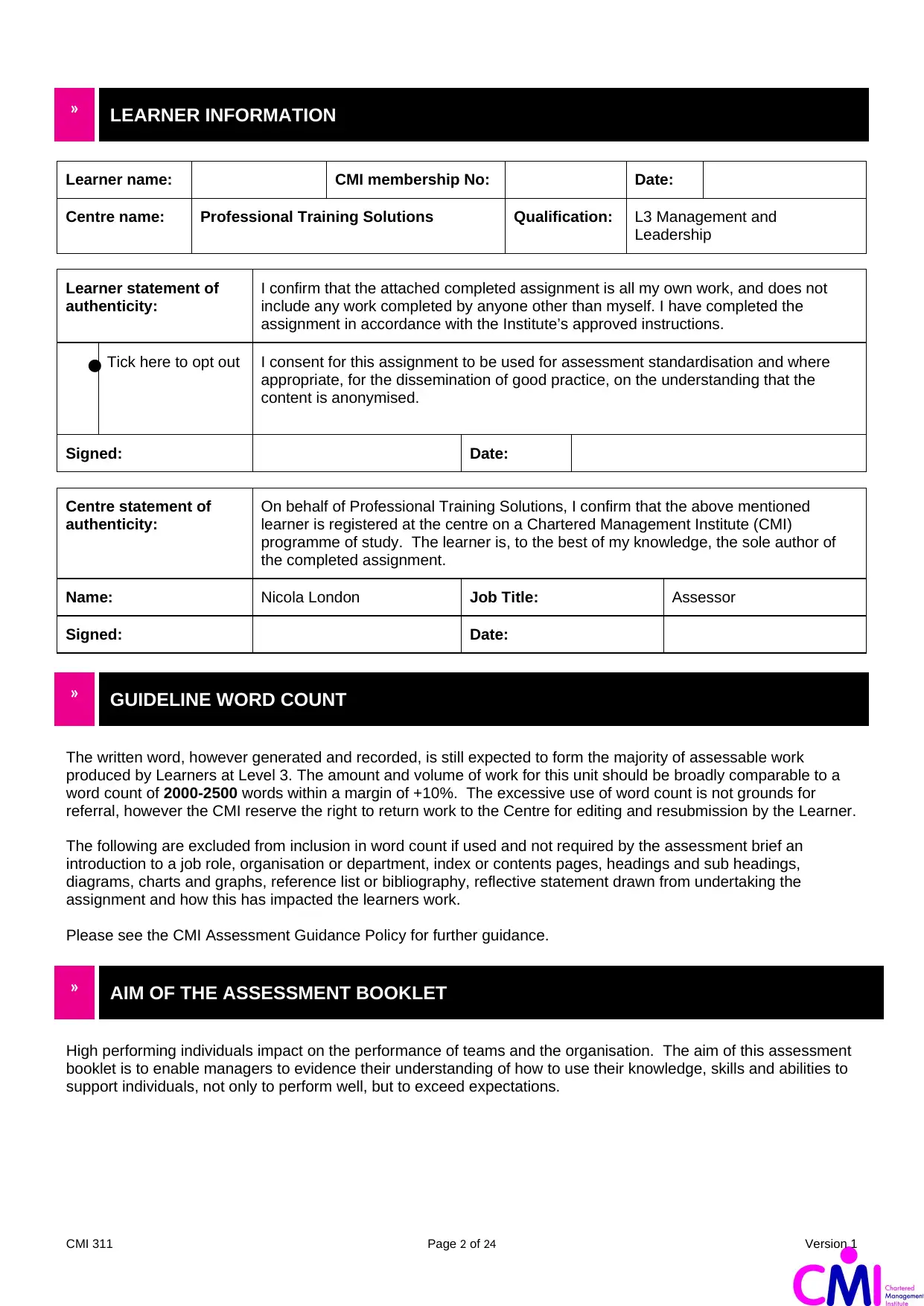
» LEARNER INFORMATION
Learner name: CMI membership No: Date:
Centre name: Professional Training Solutions Qualification: L3 Management and
Leadership
Learner statement of
authenticity:
I confirm that the attached completed assignment is all my own work, and does not
include any work completed by anyone other than myself. I have completed the
assignment in accordance with the Institute’s approved instructions.
Tick here to opt out I consent for this assignment to be used for assessment standardisation and where
appropriate, for the dissemination of good practice, on the understanding that the
content is anonymised.
Signed: Date:
Centre statement of
authenticity:
On behalf of Professional Training Solutions, I confirm that the above mentioned
learner is registered at the centre on a Chartered Management Institute (CMI)
programme of study. The learner is, to the best of my knowledge, the sole author of
the completed assignment.
Name: Nicola London Job Title: Assessor
Signed: Date:
» GUIDELINE WORD COUNT
The written word, however generated and recorded, is still expected to form the majority of assessable work
produced by Learners at Level 3. The amount and volume of work for this unit should be broadly comparable to a
word count of 2000-2500 words within a margin of +10%. The excessive use of word count is not grounds for
referral, however the CMI reserve the right to return work to the Centre for editing and resubmission by the Learner.
The following are excluded from inclusion in word count if used and not required by the assessment brief an
introduction to a job role, organisation or department, index or contents pages, headings and sub headings,
diagrams, charts and graphs, reference list or bibliography, reflective statement drawn from undertaking the
assignment and how this has impacted the learners work.
Please see the CMI Assessment Guidance Policy for further guidance.
» AIM OF THE ASSESSMENT BOOKLET
High performing individuals impact on the performance of teams and the organisation. The aim of this assessment
booklet is to enable managers to evidence their understanding of how to use their knowledge, skills and abilities to
support individuals, not only to perform well, but to exceed expectations.
CMI 311 Page 2 of 24 Version 1
Learner name: CMI membership No: Date:
Centre name: Professional Training Solutions Qualification: L3 Management and
Leadership
Learner statement of
authenticity:
I confirm that the attached completed assignment is all my own work, and does not
include any work completed by anyone other than myself. I have completed the
assignment in accordance with the Institute’s approved instructions.
Tick here to opt out I consent for this assignment to be used for assessment standardisation and where
appropriate, for the dissemination of good practice, on the understanding that the
content is anonymised.
Signed: Date:
Centre statement of
authenticity:
On behalf of Professional Training Solutions, I confirm that the above mentioned
learner is registered at the centre on a Chartered Management Institute (CMI)
programme of study. The learner is, to the best of my knowledge, the sole author of
the completed assignment.
Name: Nicola London Job Title: Assessor
Signed: Date:
» GUIDELINE WORD COUNT
The written word, however generated and recorded, is still expected to form the majority of assessable work
produced by Learners at Level 3. The amount and volume of work for this unit should be broadly comparable to a
word count of 2000-2500 words within a margin of +10%. The excessive use of word count is not grounds for
referral, however the CMI reserve the right to return work to the Centre for editing and resubmission by the Learner.
The following are excluded from inclusion in word count if used and not required by the assessment brief an
introduction to a job role, organisation or department, index or contents pages, headings and sub headings,
diagrams, charts and graphs, reference list or bibliography, reflective statement drawn from undertaking the
assignment and how this has impacted the learners work.
Please see the CMI Assessment Guidance Policy for further guidance.
» AIM OF THE ASSESSMENT BOOKLET
High performing individuals impact on the performance of teams and the organisation. The aim of this assessment
booklet is to enable managers to evidence their understanding of how to use their knowledge, skills and abilities to
support individuals, not only to perform well, but to exceed expectations.
CMI 311 Page 2 of 24 Version 1
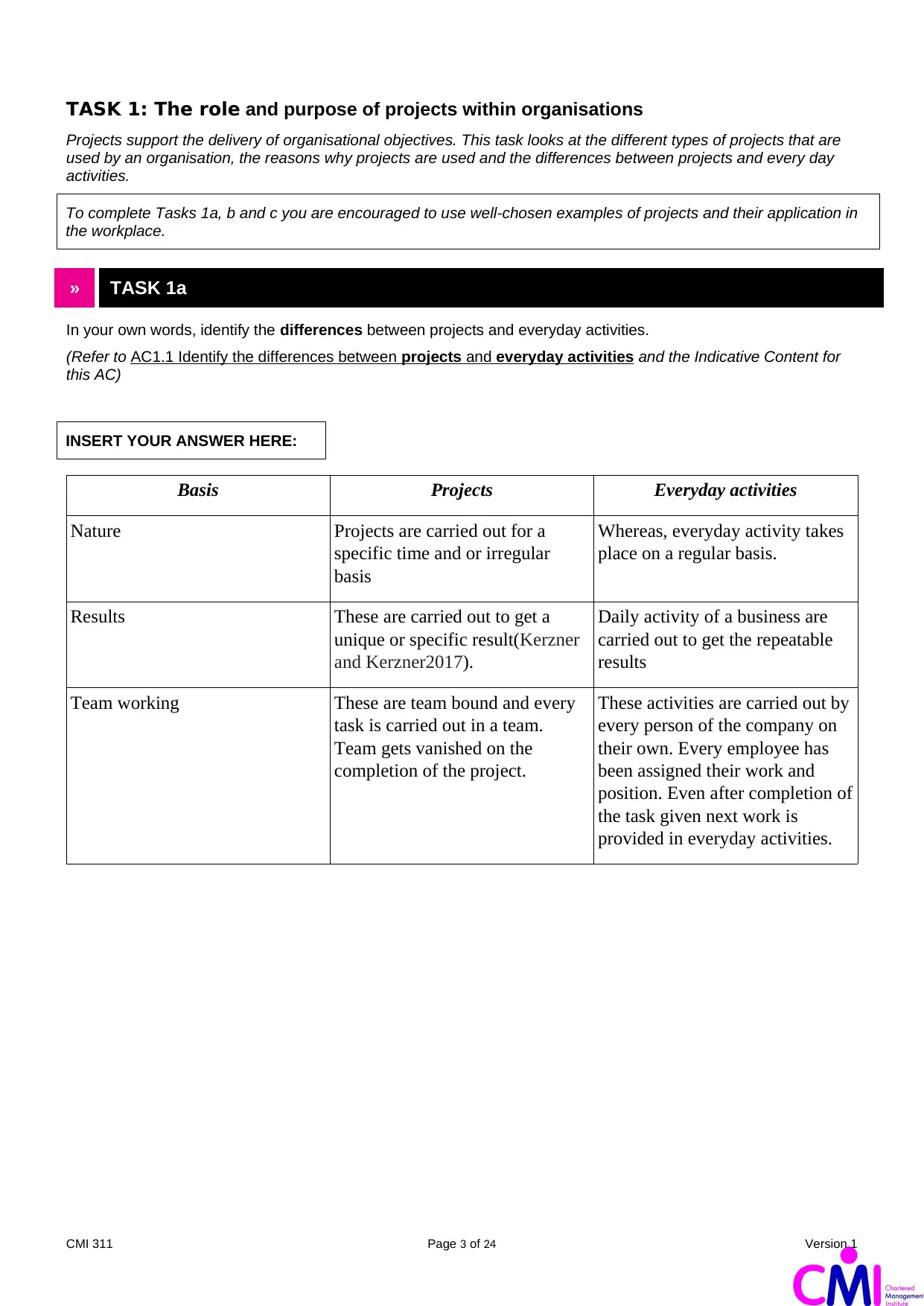
TASK 1: The role and purpose of projects within organisations
Projects support the delivery of organisational objectives. This task looks at the different types of projects that are
used by an organisation, the reasons why projects are used and the differences between projects and every day
activities.
To complete Tasks 1a, b and c you are encouraged to use well-chosen examples of projects and their application in
the workplace.
» TASK 1a
In your own words, identify the differences between projects and everyday activities.
(Refer to AC1.1 Identify the differences between projects and everyday activities and the Indicative Content for
this AC)
INSERT YOUR ANSWER HERE:
Basis Projects Everyday activities
Nature Projects are carried out for a
specific time and or irregular
basis
Whereas, everyday activity takes
place on a regular basis.
Results These are carried out to get a
unique or specific result(Kerzner
and Kerzner2017).
Daily activity of a business are
carried out to get the repeatable
results
Team working These are team bound and every
task is carried out in a team.
Team gets vanished on the
completion of the project.
These activities are carried out by
every person of the company on
their own. Every employee has
been assigned their work and
position. Even after completion of
the task given next work is
provided in everyday activities.
CMI 311 Page 3 of 24 Version 1
Projects support the delivery of organisational objectives. This task looks at the different types of projects that are
used by an organisation, the reasons why projects are used and the differences between projects and every day
activities.
To complete Tasks 1a, b and c you are encouraged to use well-chosen examples of projects and their application in
the workplace.
» TASK 1a
In your own words, identify the differences between projects and everyday activities.
(Refer to AC1.1 Identify the differences between projects and everyday activities and the Indicative Content for
this AC)
INSERT YOUR ANSWER HERE:
Basis Projects Everyday activities
Nature Projects are carried out for a
specific time and or irregular
basis
Whereas, everyday activity takes
place on a regular basis.
Results These are carried out to get a
unique or specific result(Kerzner
and Kerzner2017).
Daily activity of a business are
carried out to get the repeatable
results
Team working These are team bound and every
task is carried out in a team.
Team gets vanished on the
completion of the project.
These activities are carried out by
every person of the company on
their own. Every employee has
been assigned their work and
position. Even after completion of
the task given next work is
provided in everyday activities.
CMI 311 Page 3 of 24 Version 1
⊘ This is a preview!⊘
Do you want full access?
Subscribe today to unlock all pages.

Trusted by 1+ million students worldwide
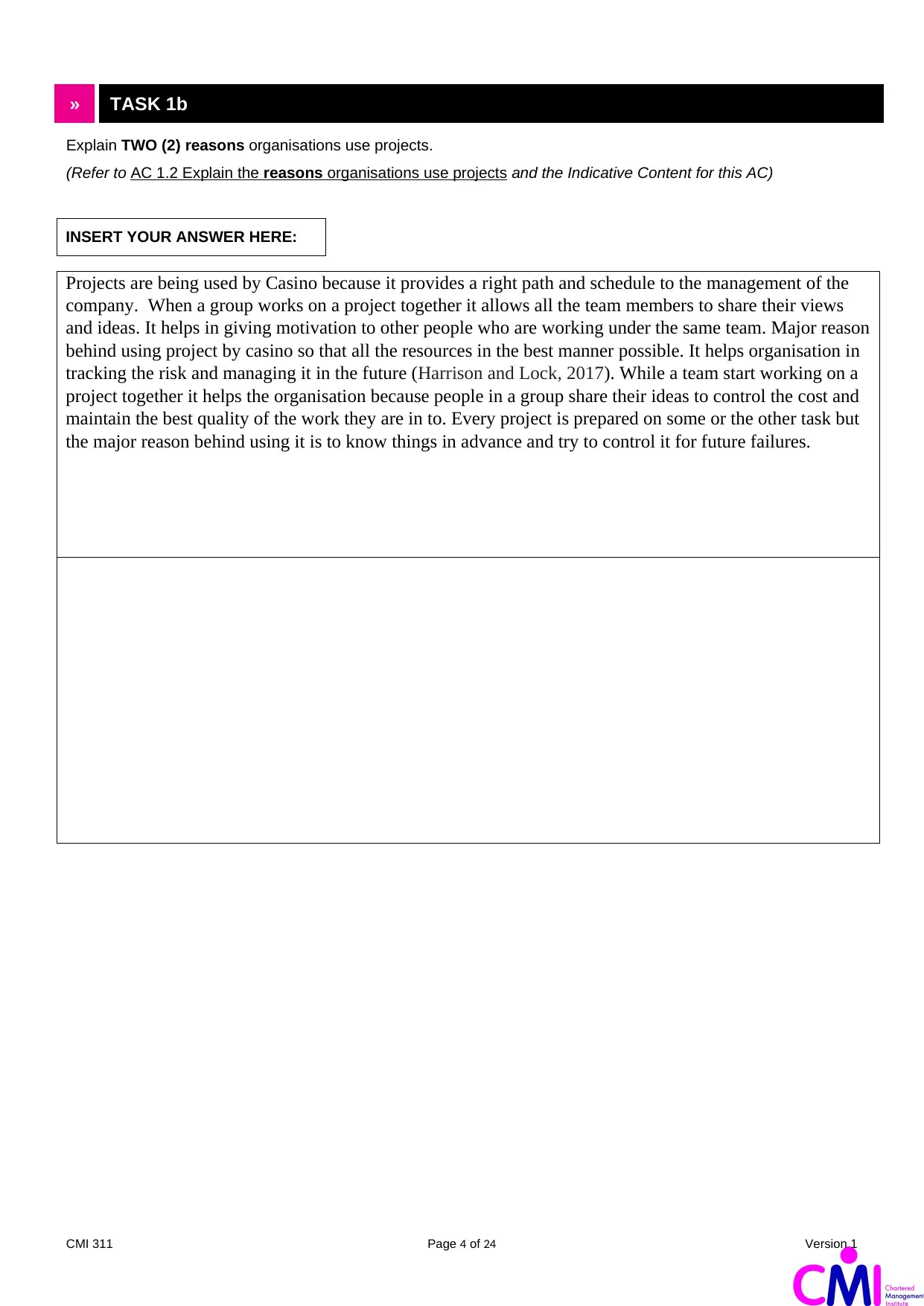
» TASK 1b
Explain TWO (2) reasons organisations use projects.
(Refer to AC 1.2 Explain the reasons organisations use projects and the Indicative Content for this AC)
INSERT YOUR ANSWER HERE:
Projects are being used by Casino because it provides a right path and schedule to the management of the
company. When a group works on a project together it allows all the team members to share their views
and ideas. It helps in giving motivation to other people who are working under the same team. Major reason
behind using project by casino so that all the resources in the best manner possible. It helps organisation in
tracking the risk and managing it in the future (Harrison and Lock, 2017). While a team start working on a
project together it helps the organisation because people in a group share their ideas to control the cost and
maintain the best quality of the work they are in to. Every project is prepared on some or the other task but
the major reason behind using it is to know things in advance and try to control it for future failures.
CMI 311 Page 4 of 24 Version 1
Explain TWO (2) reasons organisations use projects.
(Refer to AC 1.2 Explain the reasons organisations use projects and the Indicative Content for this AC)
INSERT YOUR ANSWER HERE:
Projects are being used by Casino because it provides a right path and schedule to the management of the
company. When a group works on a project together it allows all the team members to share their views
and ideas. It helps in giving motivation to other people who are working under the same team. Major reason
behind using project by casino so that all the resources in the best manner possible. It helps organisation in
tracking the risk and managing it in the future (Harrison and Lock, 2017). While a team start working on a
project together it helps the organisation because people in a group share their ideas to control the cost and
maintain the best quality of the work they are in to. Every project is prepared on some or the other task but
the major reason behind using it is to know things in advance and try to control it for future failures.
CMI 311 Page 4 of 24 Version 1
Paraphrase This Document
Need a fresh take? Get an instant paraphrase of this document with our AI Paraphraser
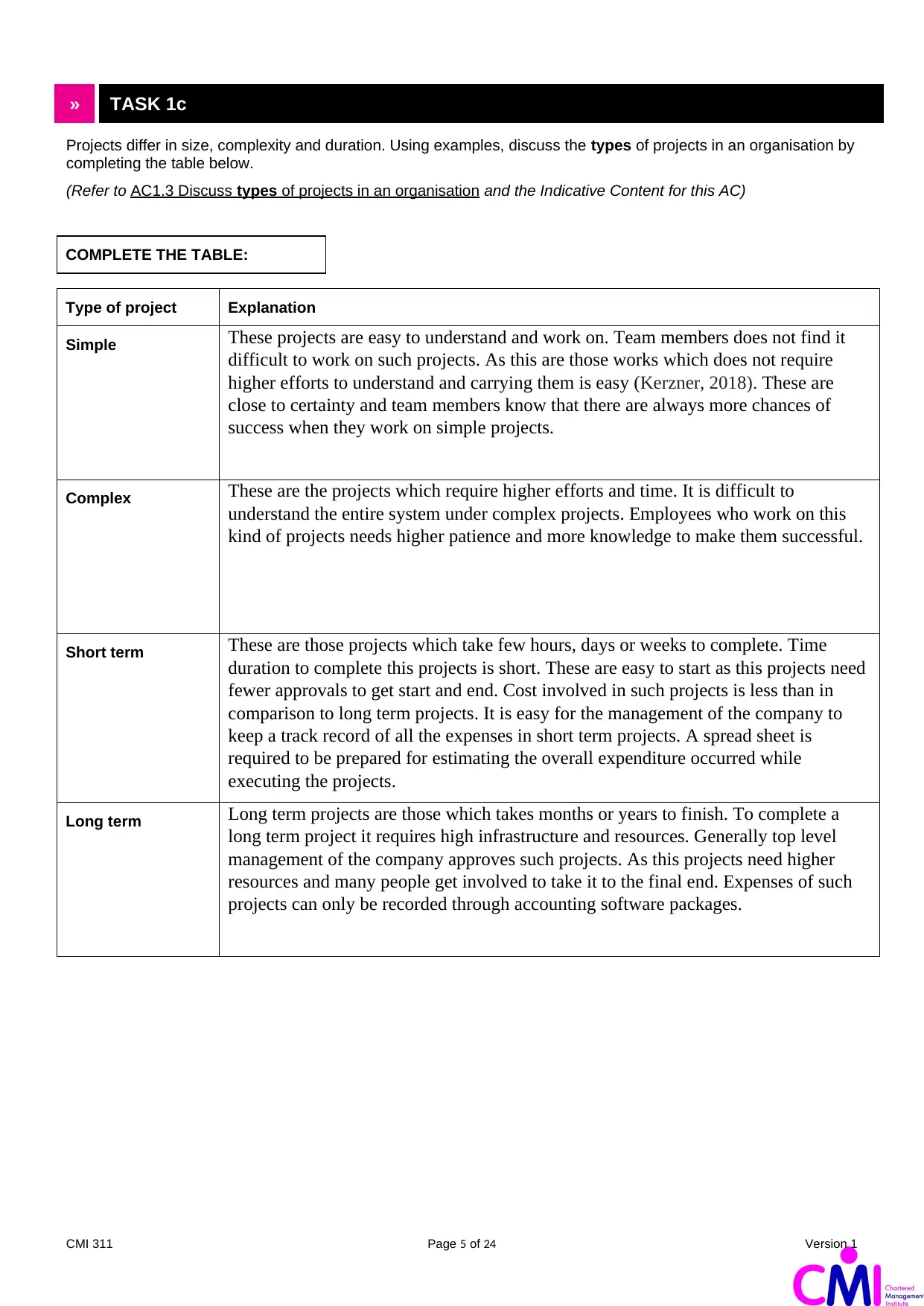
» TASK 1c
Projects differ in size, complexity and duration. Using examples, discuss the types of projects in an organisation by
completing the table below.
(Refer to AC1.3 Discuss types of projects in an organisation and the Indicative Content for this AC)
COMPLETE THE TABLE:
Type of project Explanation
Simple These projects are easy to understand and work on. Team members does not find it
difficult to work on such projects. As this are those works which does not require
higher efforts to understand and carrying them is easy (Kerzner, 2018). These are
close to certainty and team members know that there are always more chances of
success when they work on simple projects.
Complex These are the projects which require higher efforts and time. It is difficult to
understand the entire system under complex projects. Employees who work on this
kind of projects needs higher patience and more knowledge to make them successful.
Short term These are those projects which take few hours, days or weeks to complete. Time
duration to complete this projects is short. These are easy to start as this projects need
fewer approvals to get start and end. Cost involved in such projects is less than in
comparison to long term projects. It is easy for the management of the company to
keep a track record of all the expenses in short term projects. A spread sheet is
required to be prepared for estimating the overall expenditure occurred while
executing the projects.
Long term Long term projects are those which takes months or years to finish. To complete a
long term project it requires high infrastructure and resources. Generally top level
management of the company approves such projects. As this projects need higher
resources and many people get involved to take it to the final end. Expenses of such
projects can only be recorded through accounting software packages.
CMI 311 Page 5 of 24 Version 1
Projects differ in size, complexity and duration. Using examples, discuss the types of projects in an organisation by
completing the table below.
(Refer to AC1.3 Discuss types of projects in an organisation and the Indicative Content for this AC)
COMPLETE THE TABLE:
Type of project Explanation
Simple These projects are easy to understand and work on. Team members does not find it
difficult to work on such projects. As this are those works which does not require
higher efforts to understand and carrying them is easy (Kerzner, 2018). These are
close to certainty and team members know that there are always more chances of
success when they work on simple projects.
Complex These are the projects which require higher efforts and time. It is difficult to
understand the entire system under complex projects. Employees who work on this
kind of projects needs higher patience and more knowledge to make them successful.
Short term These are those projects which take few hours, days or weeks to complete. Time
duration to complete this projects is short. These are easy to start as this projects need
fewer approvals to get start and end. Cost involved in such projects is less than in
comparison to long term projects. It is easy for the management of the company to
keep a track record of all the expenses in short term projects. A spread sheet is
required to be prepared for estimating the overall expenditure occurred while
executing the projects.
Long term Long term projects are those which takes months or years to finish. To complete a
long term project it requires high infrastructure and resources. Generally top level
management of the company approves such projects. As this projects need higher
resources and many people get involved to take it to the final end. Expenses of such
projects can only be recorded through accounting software packages.
CMI 311 Page 5 of 24 Version 1
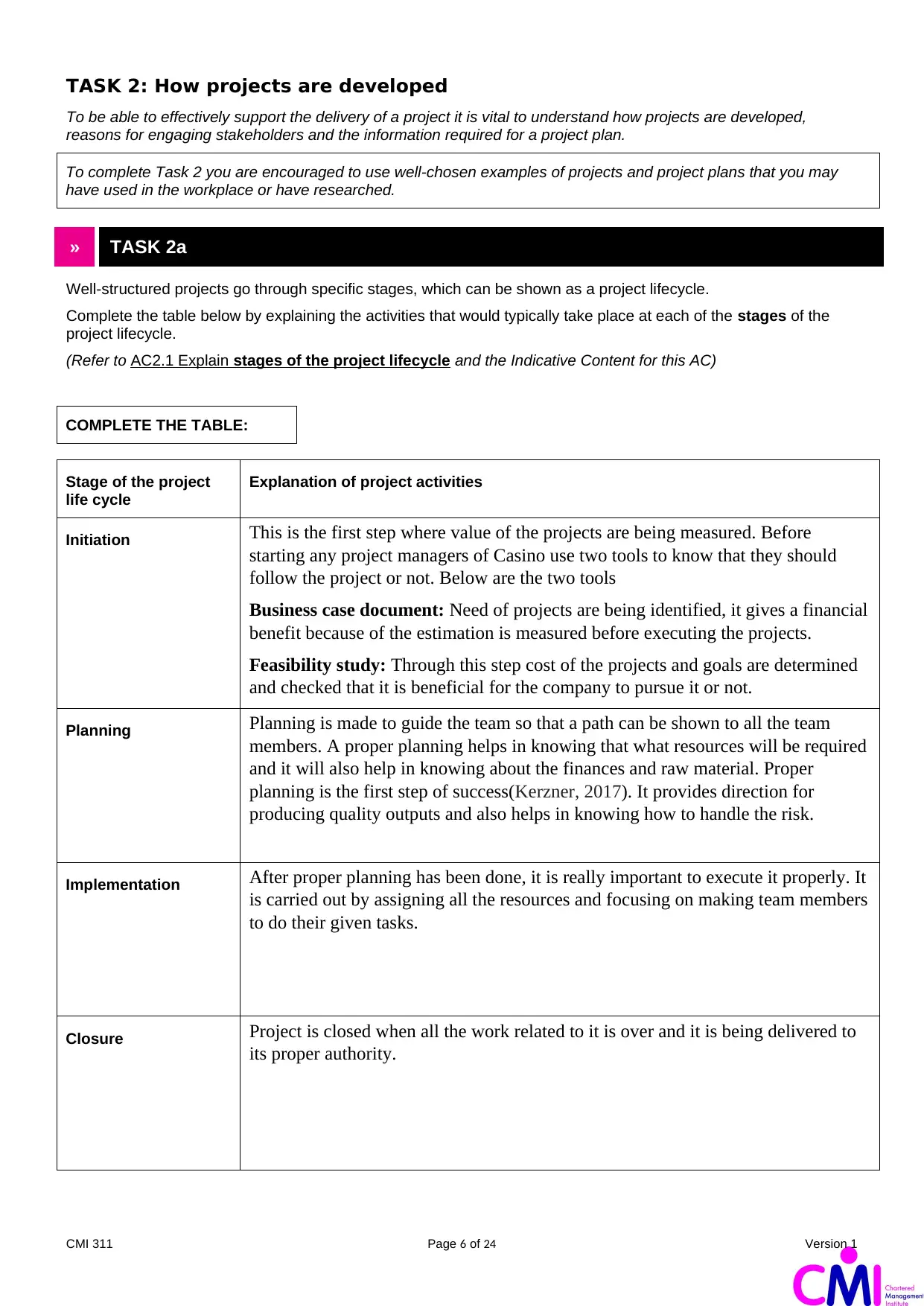
TASK 2: How projects are developed
To be able to effectively support the delivery of a project it is vital to understand how projects are developed,
reasons for engaging stakeholders and the information required for a project plan.
To complete Task 2 you are encouraged to use well-chosen examples of projects and project plans that you may
have used in the workplace or have researched.
» TASK 2a
Well-structured projects go through specific stages, which can be shown as a project lifecycle.
Complete the table below by explaining the activities that would typically take place at each of the stages of the
project lifecycle.
(Refer to AC2.1 Explain stages of the project lifecycle and the Indicative Content for this AC)
COMPLETE THE TABLE:
Stage of the project
life cycle
Explanation of project activities
Initiation This is the first step where value of the projects are being measured. Before
starting any project managers of Casino use two tools to know that they should
follow the project or not. Below are the two tools
Business case document: Need of projects are being identified, it gives a financial
benefit because of the estimation is measured before executing the projects.
Feasibility study: Through this step cost of the projects and goals are determined
and checked that it is beneficial for the company to pursue it or not.
Planning Planning is made to guide the team so that a path can be shown to all the team
members. A proper planning helps in knowing that what resources will be required
and it will also help in knowing about the finances and raw material. Proper
planning is the first step of success(Kerzner, 2017). It provides direction for
producing quality outputs and also helps in knowing how to handle the risk.
Implementation After proper planning has been done, it is really important to execute it properly. It
is carried out by assigning all the resources and focusing on making team members
to do their given tasks.
Closure Project is closed when all the work related to it is over and it is being delivered to
its proper authority.
CMI 311 Page 6 of 24 Version 1
To be able to effectively support the delivery of a project it is vital to understand how projects are developed,
reasons for engaging stakeholders and the information required for a project plan.
To complete Task 2 you are encouraged to use well-chosen examples of projects and project plans that you may
have used in the workplace or have researched.
» TASK 2a
Well-structured projects go through specific stages, which can be shown as a project lifecycle.
Complete the table below by explaining the activities that would typically take place at each of the stages of the
project lifecycle.
(Refer to AC2.1 Explain stages of the project lifecycle and the Indicative Content for this AC)
COMPLETE THE TABLE:
Stage of the project
life cycle
Explanation of project activities
Initiation This is the first step where value of the projects are being measured. Before
starting any project managers of Casino use two tools to know that they should
follow the project or not. Below are the two tools
Business case document: Need of projects are being identified, it gives a financial
benefit because of the estimation is measured before executing the projects.
Feasibility study: Through this step cost of the projects and goals are determined
and checked that it is beneficial for the company to pursue it or not.
Planning Planning is made to guide the team so that a path can be shown to all the team
members. A proper planning helps in knowing that what resources will be required
and it will also help in knowing about the finances and raw material. Proper
planning is the first step of success(Kerzner, 2017). It provides direction for
producing quality outputs and also helps in knowing how to handle the risk.
Implementation After proper planning has been done, it is really important to execute it properly. It
is carried out by assigning all the resources and focusing on making team members
to do their given tasks.
Closure Project is closed when all the work related to it is over and it is being delivered to
its proper authority.
CMI 311 Page 6 of 24 Version 1
⊘ This is a preview!⊘
Do you want full access?
Subscribe today to unlock all pages.

Trusted by 1+ million students worldwide
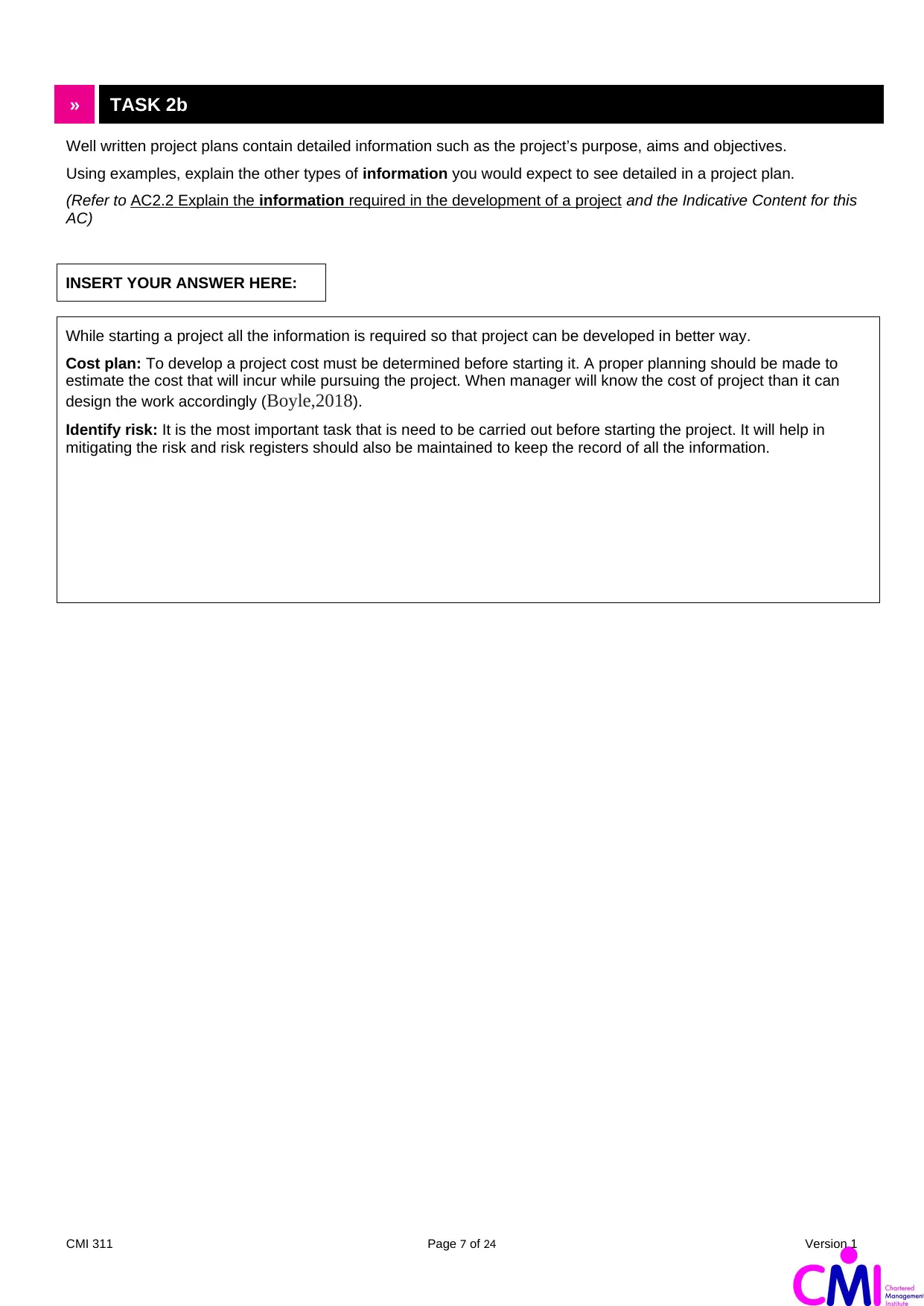
» TASK 2b
Well written project plans contain detailed information such as the project’s purpose, aims and objectives.
Using examples, explain the other types of information you would expect to see detailed in a project plan.
(Refer to AC2.2 Explain the information required in the development of a project and the Indicative Content for this
AC)
INSERT YOUR ANSWER HERE:
While starting a project all the information is required so that project can be developed in better way.
Cost plan: To develop a project cost must be determined before starting it. A proper planning should be made to
estimate the cost that will incur while pursuing the project. When manager will know the cost of project than it can
design the work accordingly (Boyle,2018).
Identify risk: It is the most important task that is need to be carried out before starting the project. It will help in
mitigating the risk and risk registers should also be maintained to keep the record of all the information.
CMI 311 Page 7 of 24 Version 1
Well written project plans contain detailed information such as the project’s purpose, aims and objectives.
Using examples, explain the other types of information you would expect to see detailed in a project plan.
(Refer to AC2.2 Explain the information required in the development of a project and the Indicative Content for this
AC)
INSERT YOUR ANSWER HERE:
While starting a project all the information is required so that project can be developed in better way.
Cost plan: To develop a project cost must be determined before starting it. A proper planning should be made to
estimate the cost that will incur while pursuing the project. When manager will know the cost of project than it can
design the work accordingly (Boyle,2018).
Identify risk: It is the most important task that is need to be carried out before starting the project. It will help in
mitigating the risk and risk registers should also be maintained to keep the record of all the information.
CMI 311 Page 7 of 24 Version 1
Paraphrase This Document
Need a fresh take? Get an instant paraphrase of this document with our AI Paraphraser
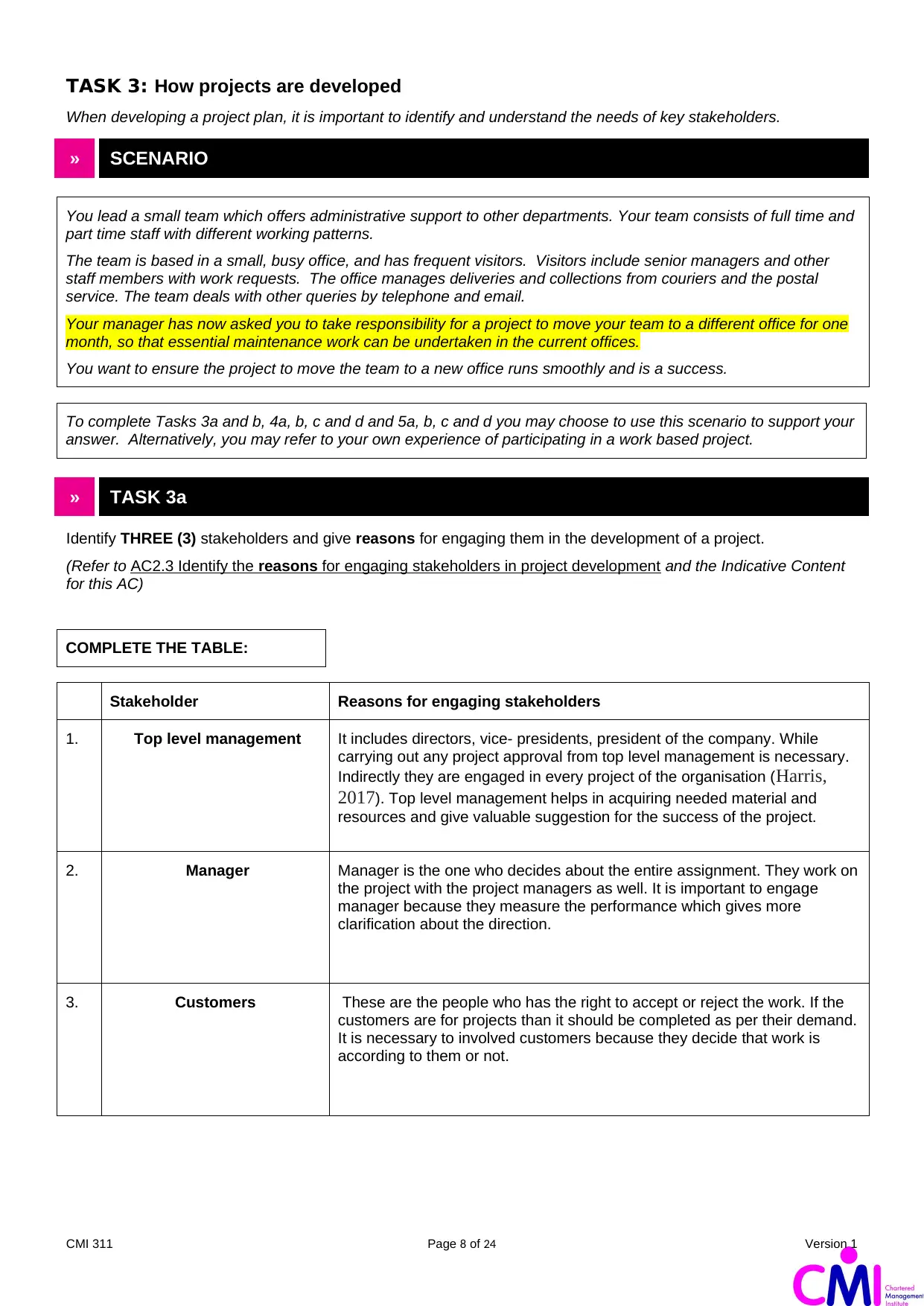
TASK 3: How projects are developed
When developing a project plan, it is important to identify and understand the needs of key stakeholders.
» SCENARIO
You lead a small team which offers administrative support to other departments. Your team consists of full time and
part time staff with different working patterns.
The team is based in a small, busy office, and has frequent visitors. Visitors include senior managers and other
staff members with work requests. The office manages deliveries and collections from couriers and the postal
service. The team deals with other queries by telephone and email.
Your manager has now asked you to take responsibility for a project to move your team to a different office for one
month, so that essential maintenance work can be undertaken in the current offices.
You want to ensure the project to move the team to a new office runs smoothly and is a success.
To complete Tasks 3a and b, 4a, b, c and d and 5a, b, c and d you may choose to use this scenario to support your
answer. Alternatively, you may refer to your own experience of participating in a work based project.
» TASK 3a
Identify THREE (3) stakeholders and give reasons for engaging them in the development of a project.
(Refer to AC2.3 Identify the reasons for engaging stakeholders in project development and the Indicative Content
for this AC)
COMPLETE THE TABLE:
Stakeholder Reasons for engaging stakeholders
1. Top level management It includes directors, vice- presidents, president of the company. While
carrying out any project approval from top level management is necessary.
Indirectly they are engaged in every project of the organisation (Harris,
2017). Top level management helps in acquiring needed material and
resources and give valuable suggestion for the success of the project.
2. Manager Manager is the one who decides about the entire assignment. They work on
the project with the project managers as well. It is important to engage
manager because they measure the performance which gives more
clarification about the direction.
3. Customers These are the people who has the right to accept or reject the work. If the
customers are for projects than it should be completed as per their demand.
It is necessary to involved customers because they decide that work is
according to them or not.
CMI 311 Page 8 of 24 Version 1
When developing a project plan, it is important to identify and understand the needs of key stakeholders.
» SCENARIO
You lead a small team which offers administrative support to other departments. Your team consists of full time and
part time staff with different working patterns.
The team is based in a small, busy office, and has frequent visitors. Visitors include senior managers and other
staff members with work requests. The office manages deliveries and collections from couriers and the postal
service. The team deals with other queries by telephone and email.
Your manager has now asked you to take responsibility for a project to move your team to a different office for one
month, so that essential maintenance work can be undertaken in the current offices.
You want to ensure the project to move the team to a new office runs smoothly and is a success.
To complete Tasks 3a and b, 4a, b, c and d and 5a, b, c and d you may choose to use this scenario to support your
answer. Alternatively, you may refer to your own experience of participating in a work based project.
» TASK 3a
Identify THREE (3) stakeholders and give reasons for engaging them in the development of a project.
(Refer to AC2.3 Identify the reasons for engaging stakeholders in project development and the Indicative Content
for this AC)
COMPLETE THE TABLE:
Stakeholder Reasons for engaging stakeholders
1. Top level management It includes directors, vice- presidents, president of the company. While
carrying out any project approval from top level management is necessary.
Indirectly they are engaged in every project of the organisation (Harris,
2017). Top level management helps in acquiring needed material and
resources and give valuable suggestion for the success of the project.
2. Manager Manager is the one who decides about the entire assignment. They work on
the project with the project managers as well. It is important to engage
manager because they measure the performance which gives more
clarification about the direction.
3. Customers These are the people who has the right to accept or reject the work. If the
customers are for projects than it should be completed as per their demand.
It is necessary to involved customers because they decide that work is
according to them or not.
CMI 311 Page 8 of 24 Version 1
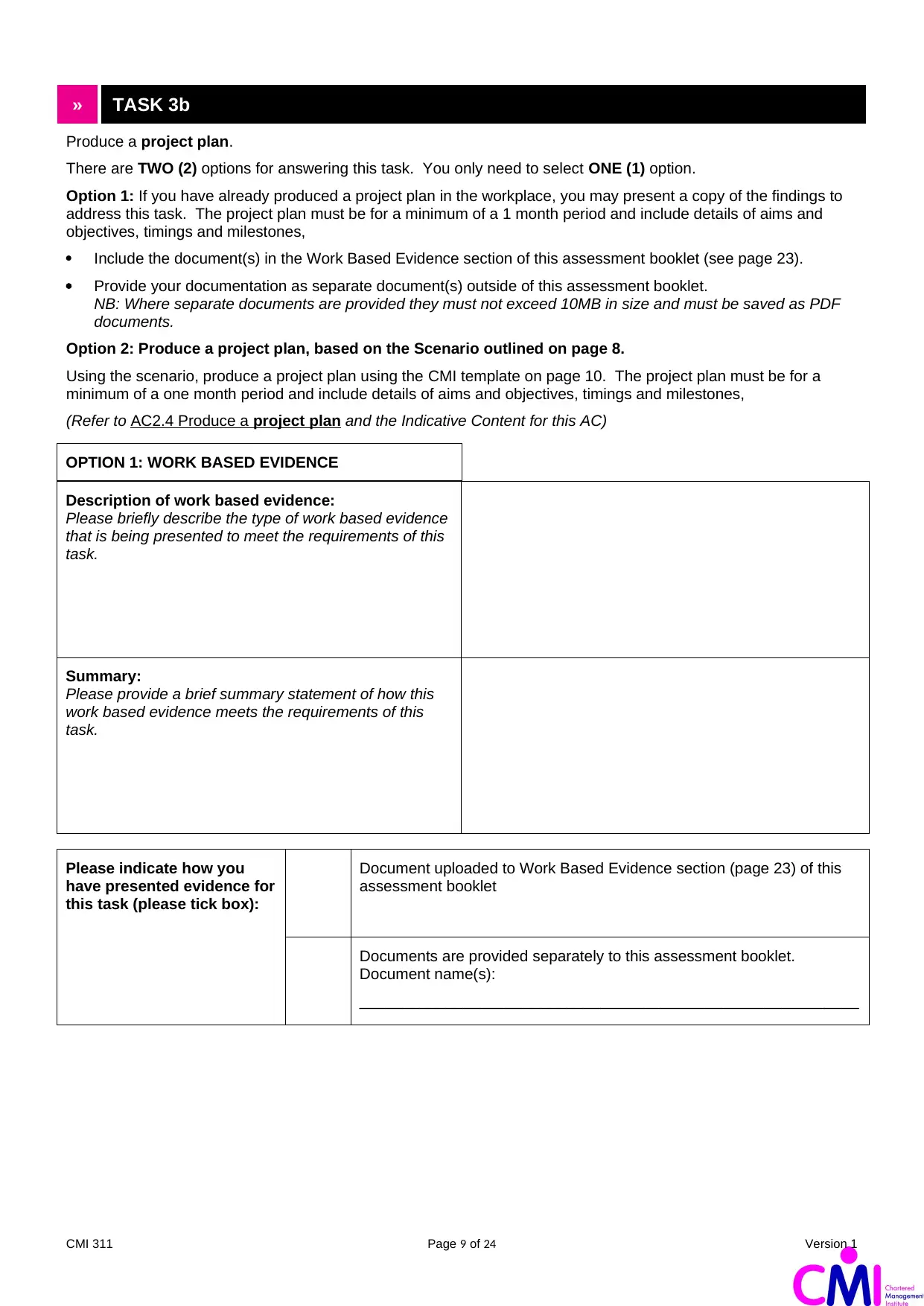
» TASK 3b
Produce a project plan.
There are TWO (2) options for answering this task. You only need to select ONE (1) option.
Option 1: If you have already produced a project plan in the workplace, you may present a copy of the findings to
address this task. The project plan must be for a minimum of a 1 month period and include details of aims and
objectives, timings and milestones,
Include the document(s) in the Work Based Evidence section of this assessment booklet (see page 23).
Provide your documentation as separate document(s) outside of this assessment booklet.
NB: Where separate documents are provided they must not exceed 10MB in size and must be saved as PDF
documents.
Option 2: Produce a project plan, based on the Scenario outlined on page 8.
Using the scenario, produce a project plan using the CMI template on page 10. The project plan must be for a
minimum of a one month period and include details of aims and objectives, timings and milestones,
(Refer to AC2.4 Produce a project plan and the Indicative Content for this AC)
OPTION 1: WORK BASED EVIDENCE
Description of work based evidence:
Please briefly describe the type of work based evidence
that is being presented to meet the requirements of this
task.
Summary:
Please provide a brief summary statement of how this
work based evidence meets the requirements of this
task.
Please indicate how you
have presented evidence for
this task (please tick box):
Document uploaded to Work Based Evidence section (page 23) of this
assessment booklet
Documents are provided separately to this assessment booklet.
Document name(s):
__________________________________________________________
CMI 311 Page 9 of 24 Version 1
Produce a project plan.
There are TWO (2) options for answering this task. You only need to select ONE (1) option.
Option 1: If you have already produced a project plan in the workplace, you may present a copy of the findings to
address this task. The project plan must be for a minimum of a 1 month period and include details of aims and
objectives, timings and milestones,
Include the document(s) in the Work Based Evidence section of this assessment booklet (see page 23).
Provide your documentation as separate document(s) outside of this assessment booklet.
NB: Where separate documents are provided they must not exceed 10MB in size and must be saved as PDF
documents.
Option 2: Produce a project plan, based on the Scenario outlined on page 8.
Using the scenario, produce a project plan using the CMI template on page 10. The project plan must be for a
minimum of a one month period and include details of aims and objectives, timings and milestones,
(Refer to AC2.4 Produce a project plan and the Indicative Content for this AC)
OPTION 1: WORK BASED EVIDENCE
Description of work based evidence:
Please briefly describe the type of work based evidence
that is being presented to meet the requirements of this
task.
Summary:
Please provide a brief summary statement of how this
work based evidence meets the requirements of this
task.
Please indicate how you
have presented evidence for
this task (please tick box):
Document uploaded to Work Based Evidence section (page 23) of this
assessment booklet
Documents are provided separately to this assessment booklet.
Document name(s):
__________________________________________________________
CMI 311 Page 9 of 24 Version 1
⊘ This is a preview!⊘
Do you want full access?
Subscribe today to unlock all pages.

Trusted by 1+ million students worldwide
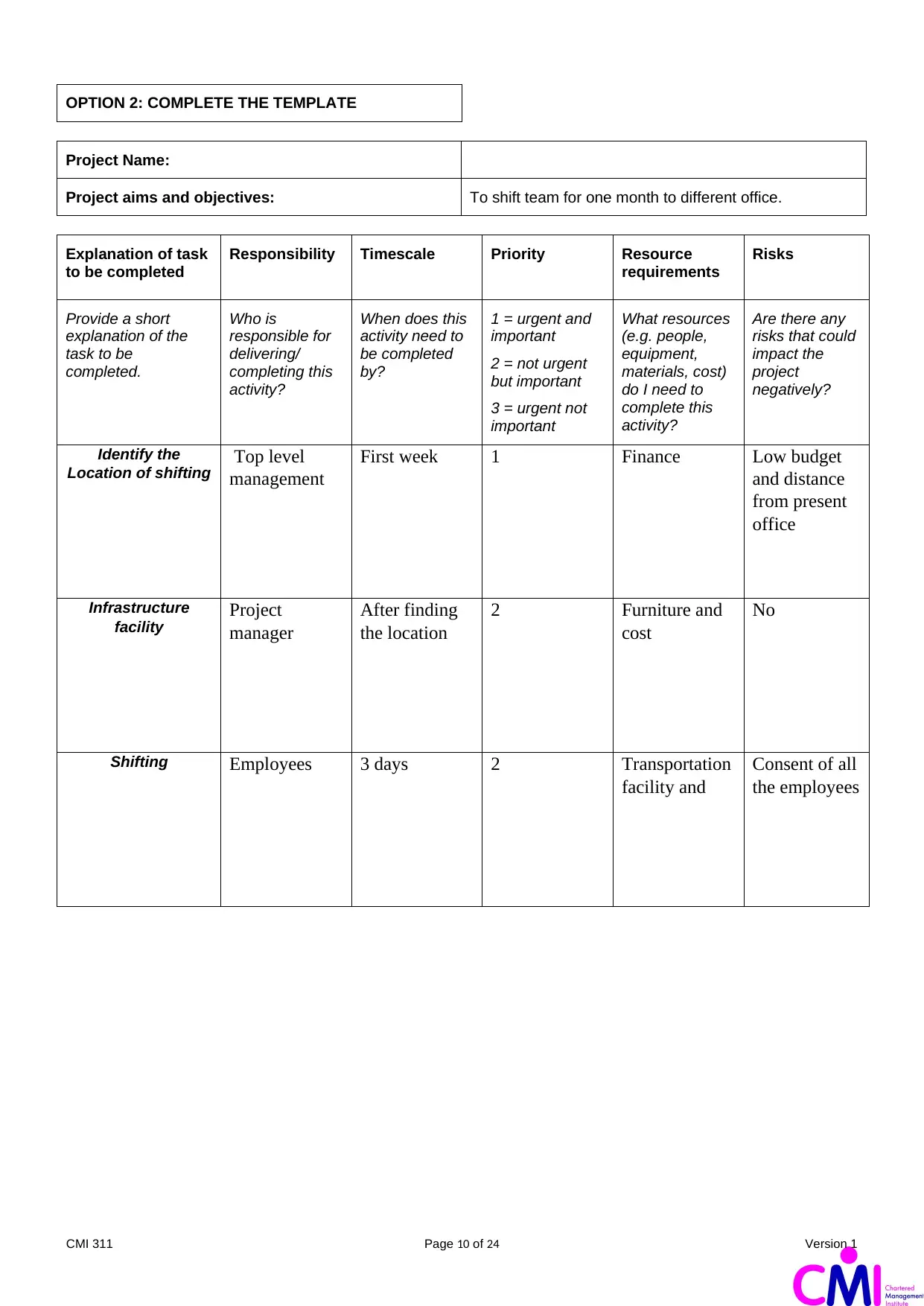
OPTION 2: COMPLETE THE TEMPLATE
Project Name:
Project aims and objectives: To shift team for one month to different office.
Explanation of task
to be completed
Responsibility Timescale Priority Resource
requirements
Risks
Provide a short
explanation of the
task to be
completed.
Who is
responsible for
delivering/
completing this
activity?
When does this
activity need to
be completed
by?
1 = urgent and
important
2 = not urgent
but important
3 = urgent not
important
What resources
(e.g. people,
equipment,
materials, cost)
do I need to
complete this
activity?
Are there any
risks that could
impact the
project
negatively?
Identify the
Location of shifting
Top level
management
First week 1 Finance Low budget
and distance
from present
office
Infrastructure
facility
Project
manager
After finding
the location
2 Furniture and
cost
No
Shifting Employees 3 days 2 Transportation
facility and
Consent of all
the employees
CMI 311 Page 10 of 24 Version 1
Project Name:
Project aims and objectives: To shift team for one month to different office.
Explanation of task
to be completed
Responsibility Timescale Priority Resource
requirements
Risks
Provide a short
explanation of the
task to be
completed.
Who is
responsible for
delivering/
completing this
activity?
When does this
activity need to
be completed
by?
1 = urgent and
important
2 = not urgent
but important
3 = urgent not
important
What resources
(e.g. people,
equipment,
materials, cost)
do I need to
complete this
activity?
Are there any
risks that could
impact the
project
negatively?
Identify the
Location of shifting
Top level
management
First week 1 Finance Low budget
and distance
from present
office
Infrastructure
facility
Project
manager
After finding
the location
2 Furniture and
cost
No
Shifting Employees 3 days 2 Transportation
facility and
Consent of all
the employees
CMI 311 Page 10 of 24 Version 1
Paraphrase This Document
Need a fresh take? Get an instant paraphrase of this document with our AI Paraphraser
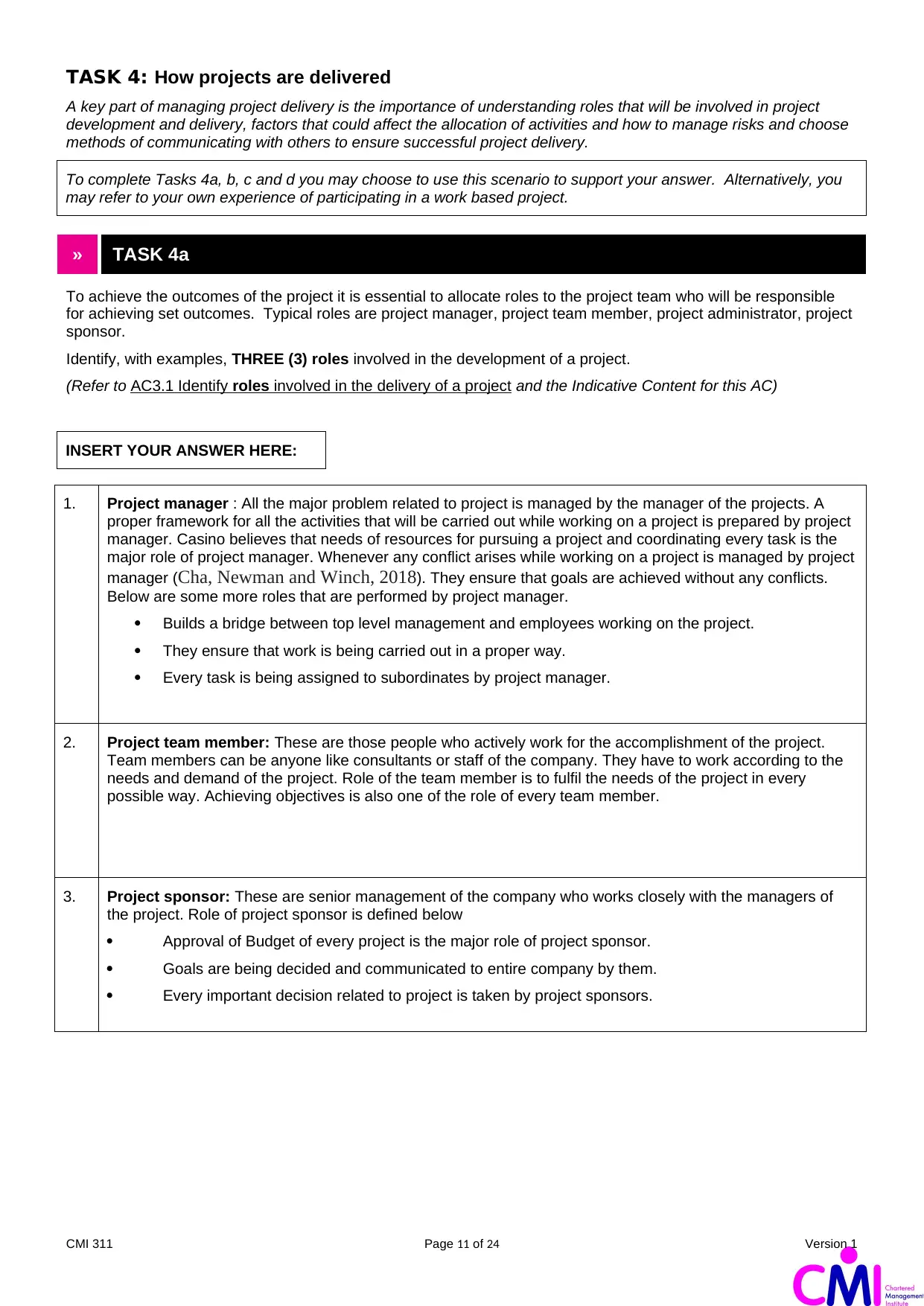
TASK 4: How projects are delivered
A key part of managing project delivery is the importance of understanding roles that will be involved in project
development and delivery, factors that could affect the allocation of activities and how to manage risks and choose
methods of communicating with others to ensure successful project delivery.
To complete Tasks 4a, b, c and d you may choose to use this scenario to support your answer. Alternatively, you
may refer to your own experience of participating in a work based project.
» TASK 4a
To achieve the outcomes of the project it is essential to allocate roles to the project team who will be responsible
for achieving set outcomes. Typical roles are project manager, project team member, project administrator, project
sponsor.
Identify, with examples, THREE (3) roles involved in the development of a project.
(Refer to AC3.1 Identify roles involved in the delivery of a project and the Indicative Content for this AC)
INSERT YOUR ANSWER HERE:
1. Project manager : All the major problem related to project is managed by the manager of the projects. A
proper framework for all the activities that will be carried out while working on a project is prepared by project
manager. Casino believes that needs of resources for pursuing a project and coordinating every task is the
major role of project manager. Whenever any conflict arises while working on a project is managed by project
manager (Cha, Newman and Winch, 2018). They ensure that goals are achieved without any conflicts.
Below are some more roles that are performed by project manager.
Builds a bridge between top level management and employees working on the project.
They ensure that work is being carried out in a proper way.
Every task is being assigned to subordinates by project manager.
2. Project team member: These are those people who actively work for the accomplishment of the project.
Team members can be anyone like consultants or staff of the company. They have to work according to the
needs and demand of the project. Role of the team member is to fulfil the needs of the project in every
possible way. Achieving objectives is also one of the role of every team member.
3. Project sponsor: These are senior management of the company who works closely with the managers of
the project. Role of project sponsor is defined below
Approval of Budget of every project is the major role of project sponsor.
Goals are being decided and communicated to entire company by them.
Every important decision related to project is taken by project sponsors.
CMI 311 Page 11 of 24 Version 1
A key part of managing project delivery is the importance of understanding roles that will be involved in project
development and delivery, factors that could affect the allocation of activities and how to manage risks and choose
methods of communicating with others to ensure successful project delivery.
To complete Tasks 4a, b, c and d you may choose to use this scenario to support your answer. Alternatively, you
may refer to your own experience of participating in a work based project.
» TASK 4a
To achieve the outcomes of the project it is essential to allocate roles to the project team who will be responsible
for achieving set outcomes. Typical roles are project manager, project team member, project administrator, project
sponsor.
Identify, with examples, THREE (3) roles involved in the development of a project.
(Refer to AC3.1 Identify roles involved in the delivery of a project and the Indicative Content for this AC)
INSERT YOUR ANSWER HERE:
1. Project manager : All the major problem related to project is managed by the manager of the projects. A
proper framework for all the activities that will be carried out while working on a project is prepared by project
manager. Casino believes that needs of resources for pursuing a project and coordinating every task is the
major role of project manager. Whenever any conflict arises while working on a project is managed by project
manager (Cha, Newman and Winch, 2018). They ensure that goals are achieved without any conflicts.
Below are some more roles that are performed by project manager.
Builds a bridge between top level management and employees working on the project.
They ensure that work is being carried out in a proper way.
Every task is being assigned to subordinates by project manager.
2. Project team member: These are those people who actively work for the accomplishment of the project.
Team members can be anyone like consultants or staff of the company. They have to work according to the
needs and demand of the project. Role of the team member is to fulfil the needs of the project in every
possible way. Achieving objectives is also one of the role of every team member.
3. Project sponsor: These are senior management of the company who works closely with the managers of
the project. Role of project sponsor is defined below
Approval of Budget of every project is the major role of project sponsor.
Goals are being decided and communicated to entire company by them.
Every important decision related to project is taken by project sponsors.
CMI 311 Page 11 of 24 Version 1

» TASK 4b
Discuss THREE (3) factors which affect the allocation of project activities to individuals.
(Refer to AC3.2 Discuss factors affecting the allocation of project activities to individuals and the Indicative Content
for this AC)
INSERT YOUR ANSWER HERE:
CMI 311 Page 12 of 24 Version 1
Discuss THREE (3) factors which affect the allocation of project activities to individuals.
(Refer to AC3.2 Discuss factors affecting the allocation of project activities to individuals and the Indicative Content
for this AC)
INSERT YOUR ANSWER HERE:
CMI 311 Page 12 of 24 Version 1
⊘ This is a preview!⊘
Do you want full access?
Subscribe today to unlock all pages.

Trusted by 1+ million students worldwide
1 out of 24
Related Documents
Your All-in-One AI-Powered Toolkit for Academic Success.
+13062052269
info@desklib.com
Available 24*7 on WhatsApp / Email
![[object Object]](/_next/static/media/star-bottom.7253800d.svg)
Unlock your academic potential
Copyright © 2020–2025 A2Z Services. All Rights Reserved. Developed and managed by ZUCOL.





